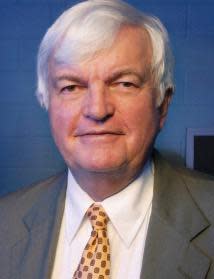Douglas Neckers: The tragedy of two diseases yet to be cured
My younger brother Craig passed away this fall, a victim of Amyotrophic Lateral sclerosis (ALS), which millions know as Lou Gehrig's Disease, after the famous ballplayer whose death in 1941 made it famous.
ALS is one of the worst diseases you can imagine. It affects the nervous system, including the brain and spinal cord. There is no cure; sufferers frequently strangle to death on their own saliva.

The disease is fortunately relatively rare, with only 5,600 cases reported each year. The symptoms of ALS can be treated, but unfortunately, the disease cannot be cured. As the disease degrades the body's motor neurons, victims gradually lose the ability to control or even initiate movement.
People with ALS gradually lose the ability to eat, speak, and even breathe. Yet in the majority of cases, their minds are largely or totally unaffected.
A few days before Craig passed away he could tell us that Thomas Dewey, the Republican presidential candidate in 1948 had visited Jamestown, N.Y., the night he was born. He had lost the ability to talk, but he could still write on his iPad. If diseases had personalities, ALS would be as nasty as they come. And the Parkinson’s disease that my wife Suzanne Evans Neckers endured for years was just as mean, and affects an estimated 1 million people.
For years, both my wife and my brother were told that the diseases they were afflicted with could not be cured. Yes, symptoms could be treated, and there were medications that perhaps would make some difference. But even those had the potential to cause side effects worse than the help they provided.
Now, I am a scientist — and as scientists are wont to do, I started to ask questions about what was happening to both of them. The first was “why?”
The second was “what’s being done?” I also asked where the research labs were and how much government money was being spent on finding cures.
The answers, in both cases, weren’t reassuring. America spends more on one nuclear submarine, than the entire budget of the National Institute of Neurological Diseases and Stroke (NINDS). With the exception of the National Cancer Institute, the money spent for neurological diseases is the largest budget of any program of the National Institutes of Health. What happened when I tried to find help for my wife when her Parkinson’s symptoms worsened illustrates the situation:
Several different neurologists did the same tests, came to more or less the same conclusions, and eventually prescribed the same medications. None were very effective, or especially tailored to her needs. Though Suzanne’s symptoms were very different than those of Michael J. Fox, she got the same pills.
But wouldn’t you suspect that a lot of research would have taken place into ways to deal with this dread disease? I looked for evidence that science had discovered biomarkers — chemical signals that suggest signs that a problem might be developing. But there were no indications that this ad been done.
The case with ALS is even more disturbing. Many people know that this is a horrible disease, and plenty of baseball fans have seen the film of Lou Gehrig standing before a microphone at Yankee Stadium on July 4, 1939, calling himself the “luckiest man on the face of the earth.” Others know that it took the life of the great physicist Stephen Hawking.
But because ALS is so comparatively rare, I think there are less than 10 laboratories in the world studying it; and most of those are engaged in clinical studies of current patients — not basic research.
This says something devastating about our national priorities. Why should we be spending more on submarines than our collective national health — especially with the Cold War now long over?
Why aren’t the funds the National Science Foundation and other government agencies being spent to understand such deadly diseases? Why aren’t we spending more to try to overcome these horrible killers?
President Biden is expected to soon appoint a new director of the National Institute of Health. I would argue that this director needs to be an aggressive salesperson for human needs — someone like the former Surgeon General, C. Everett Koop, who by the power of his voice helped persuade millions that smoking was bad, not only in this country, but worldwide.
Another good choice might be Bill Gates, who despite criticism, has been a vigorous spokesman for stomping out certain diseases across the globe. (Plus, nobody could accuse him of taking the job for the money.) Or, perhaps, my favorite world leader of the current era, recently retired German Chancellor Angela Merkel, who before politics was a highly respected chemist.
Diseases know no borders — why not step outside the national box and make her our and the world’s global health czar?
None of this is likely to happen unless people let the government know that we want our health and well-being on the front burner for a change.
If the pandemic taught us anything, it should be that our medical research community needs to make us more prepared. It’s time to stop fighting old wars and start putting the health of Americans first — even if the admirals pout because they aren’t getting enough submarines.
— Douglas Neckers is an organic chemist, the McMaster distinguished professor emeritus and the founder of the Center for Photochemical Sciences at Bowling Green State University. He is also a former board chair of the Robert H. Jackson Center in Jamestown, N.Y.
This article originally appeared on The Holland Sentinel: Douglas Neckers: The tragedy of two diseases yet to be cured
